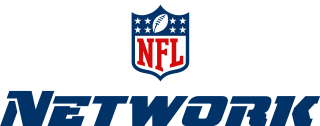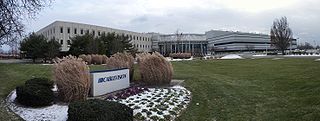
Cable television is a system of delivering television programming to consumers via radio frequency (RF) signals transmitted through coaxial cables, or in more recent systems, light pulses through fibre-optic cables. This contrasts with broadcast television, in which the television signal is transmitted over-the-air by radio waves and received by a television antenna ; or satellite television, in which the television signal is transmitted over-the-air by radio waves from a communications satellite and received by a satellite dish on the roof. FM radio programming, high-speed Internet, telephone services, and similar non-television services may also be provided through these cables. Analog television was standard in the 20th century, but since the 2000s, cable systems have been upgraded to digital cable operation.

NTL Incorporated, branded as ntl:, was a United States-listed British company founded in 1992, which provided cable television, cable internet and fixed-line cable telephone services. While NTL had its headquarters in New York City, the company's activities focused heavily on the United Kingdom, with operational headquarters in Hook, Hampshire.

Comcast Corporation, incorporated and headquartered in Philadelphia, is an American multinational telecommunications and media conglomerate. The corporation is the fourth-largest broadcasting and cable television company in the world by revenue. It is the third-largest pay-TV company, the second-largest cable TV company by subscribers, and the largest home Internet service provider in the United States. In 2023, the company was ranked 51st in the Forbes Global 2000. Comcast is additionally the nation's third-largest home telephone service provider. It provides services to U.S. residential and commercial customers in 40 states and the District of Columbia. As the owner of the international media company NBCUniversal since 2011, Comcast is also a high-volume producer of feature films for theatrical exhibition and television programming, and a theme park operator. It is the world's fourth-largest telecommunications company by revenue.
Rogers Cable Inc. is Canada's largest cable television service provider with about 2.25 million television customers, and over 930,000 Internet subscribers, primarily in Southern & Eastern Ontario, New Brunswick and Newfoundland and Labrador. Rogers Cable is a division of Rogers Communications Partnership, itself wholly owned by Rogers Communications Inc.
Public-access television is traditionally a form of non-commercial mass media where the general public can create content television programming which is narrowcast through cable television specialty channels. Public-access television was created in the United States between 1969 and 1971 by the Federal Communications Commission (FCC), under Chairman Dean Burch, based on pioneering work and advocacy of George Stoney, Red Burns, and Sidney Dean.

NFL Network is an American sports-oriented pay television network owned by the National Football League (NFL) and is part of NFL Media, which also includes NFL.com, NFL Films, NFL Mobile, NFL Now and NFL RedZone. Dedicated to American football, the network features game telecasts from the NFL, as well as NFL-related content including analysis programs, specials and documentaries. The network is headquartered in the NFL Los Angeles building located next to SoFi Stadium in Inglewood, California, and broadcasts its worldwide feed from Encompass Digital Media in Atlanta, Georgia. The network has secondary East Coast facilities in the NFL Films building in Mount Laurel, New Jersey.

Tele-Communications, Inc. (TCI) was a cable television provider in the United States, and for most of its history was controlled by Bob Magness and John Malone.
Charter Communications, Inc., is an American telecommunications and mass media company with services branded as Spectrum. With over 32 million customers in 41 states, it is the largest cable operator in the United States by subscribers, just ahead of Comcast, and the largest pay TV operator ahead of Comcast and AT&T. Charter is the fifth-largest telephone provider based on number of residential lines.

Mediacom Communications Corporation is the United States' fifth-largest cable television provider based on the number of video subscribers, and among the leading cable operators focused on serving smaller cities and towns. The company has a significant concentration of customers in the Midwest and Southeast, and is the largest broadband provider in Iowa. Founded in 1995 by Rocco B. Commisso, the current owner of the New York Cosmos and ACF Fiorentina. Mediacom is headquartered in New York and incorporated in Delaware, United States. Formerly a publicly traded firm, it went private in a $600 million transaction in March 2011 and is owned solely by Commisso as of 2011.

Comcast Cable Communications, LLC, doing business as Xfinity, is an American telecommunications business segment and division of the Comcast Corporation. It is used to market consumer cable television, internet, telephone, and wireless services provided by the company. The brand was first introduced in 2010; prior to that, these services were marketed primarily under the Comcast name.
Access Communications Co-operative Limited is a Canadian telecom cooperative based in Regina, Saskatchewan. The cooperative provides internet, cable television, telephone, smart home and security services to residential and business customers in 235 Saskatchewan communities. Its primary competitor is the provincial government crown corporation SaskTel; it is one of two cable providers in Saskatchewan, with Rogers primarily serving areas such as Moose Jaw, Prince Albert, Saskatoon, and Swift Current.

Time Warner Cable, Inc. (TWC) was an American cable television company. Before it was acquired by Charter Communications on May 18, 2016, it was ranked the second largest cable company in the United States by revenue behind only Comcast, operating in 29 states. Its corporate headquarters were located in the Time Warner Center in Midtown Manhattan, New York City, with other corporate offices in Stamford, Connecticut; Charlotte, North Carolina; and Herndon, Virginia.
Cable television first became available in the United States in 1948. By 1989, 53 million U.S. households received cable television subscriptions, with 60 percent of all U.S. households doing so in 1992. Most cable viewers in the U.S. reside in the suburbs and tend to be middle class; cable television is less common in low income, urban, and rural areas.
A local franchise authority (LFA) is a United States local government organization that, together with the Federal Communications Commission (FCC), regulates cable television service within the local government's area. In some cases the LFA is the state, while in others it might be a city, county, or municipality. The LFA is meant to address cable problems such as service related rates and charges, tier rates, customer service problems, franchise fees, signal quality, and the use of public, educational, and governmental (PEG) channels. When experiencing a problem with your cable television you should first contact the cable company itself, then the local franchise authorities, then the National Citizens Committee for Broadcasting, and finally the chairmen of the House and Senate subcommittees who oversee the FCC. Additional help can be found on the web page of the Federal Communications Commission.
The Susquehanna Pfaltzgraff Company was a conglomerate of companies that started in the 19th century with Johann George Pfaltzgraff's emigration from Germany to York, Pennsylvania.
Buckeye Broadband is a cable and telecommunications company located in Toledo, Ohio, owned by Block Communications. Buckeye Broadband provides cable television, broadband internet and home telephone services to customers in northwest Ohio and parts of southeast Michigan; in addition to its system in Toledo, Buckeye also provides services to Sandusky and Erie County in north central Ohio, which were formerly served by predecessor Erie County Cablevision.
Multichannel television in the United States has been available since at least 1948. The United States is served by multichannel television through cable television systems, direct-broadcast satellite providers, and various other wireline video providers; among the largest television providers in the U.S. are YouTube TV, DirecTV, Altice USA, Charter Communications, Comcast, Dish Network, Verizon Communications, and Cox Communications. The Telecommunications Act of 1996 defines a multichannel video programming distributor (MVPD) as "a person such as, but not limited to, a cable operator, a multichannel multipoint distribution service, a direct broadcast satellite service, or a television receive-only satellite program distributor, who makes available for purchase, by subscribers or customers, multiple channels of video programming", where a channel is defined as a "signaling path provided by a cable television system."

The Cable Television Consumer Protection and Competition Act of 1992 is a United States federal law which required cable television systems to carry most local broadcast television channels and prohibited cable operators from charging local broadcasters to carry their signal.

On December 3, 2009, telecommunications company Comcast announced its intent to acquire mass media company NBC Universal from General Electric (GE). The acquisition was subject to scrutiny from activists and government officials; their concerns primarily surrounded the potential effects of the vertical integration that the acquisition could create, as Comcast is also heavily involved in cable television and internet services in many media markets. The deal went through on January 28, 2011, resulting in Comcast owning 51% of the company until March 19, 2013, when GE divested its stake to give Comcast sole ownership. Through this acquisition, Comcast gained ownership of the National Broadcasting Company (NBC), the film studio Universal Pictures, cable channels such as Syfy, CNBC and MSNBC, and Universal Parks & Resorts, among other assets owned by NBC Universal. It has also integrated its own cable channels – including E! and Golf Channel – into NBC Universal. As a result of the acquisition, NBC Universal slightly changed its name to "NBCUniversal", rendered in camel case, to indicate the integration between NBC and Universal Studios.

Cablevision Systems Corporation was an American cable television company with systems serving areas surrounding New York City. It was the fifth-largest cable provider and ninth-largest television provider in the United States. Throughout its existence and in its final years, Cablevision exclusively served customers residing in New York, New Jersey, Connecticut, and a small part of Pennsylvania. However, at one time it provided service in as many as 19 states. Cablevision also offered high-speed Internet connections, digital cable, and VoIP phone service through its Optimum brand name. Cablevision also offered a WiFi-only mobile phone service dubbed Freewheel.









